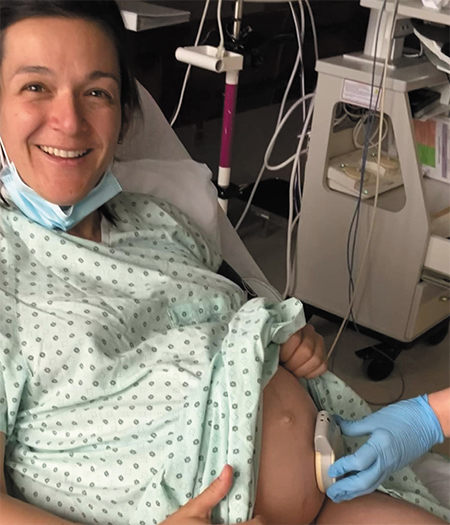Monitoring the baby’s health
Throughout the active phase of labour, the care team will regularly check on the baby’s well being by listening to his heart with an ultrasound machine. During this phase, an ultrasound is performed every 15 to 30 minutes.
Monitoring with a fetal monitor

![]() During monitoring, two sensors are strapped to your abdomen and connected to a machine that produces a monitoring strip.
During monitoring, two sensors are strapped to your abdomen and connected to a machine that produces a monitoring strip.
If your baby needs to be watched more closely, he will be monitored with a fetal monitor. The period of monitoring can vary in lenght depending on the situation. Monitoring may be intermittent or continuous.
During monitoring, two sensors are strapped to your abdomen and connected to a machine that produces a monitoring strip. One sensor tracks your baby’s heartbeat and the other records your contractions and the baby’s movements.
If the monitor bothers you or you would like to move around more, ask if you can take monitoring breaks to allow for more freedom of movement.
The staff can explain what the pattern on the monitoring strip means.
There’s no need to worry if you stop hearing your baby’s heartbeat. Most of the time it’s because you or your baby have moved and the sensor is no longer in the right place. Tell the staff so they can readjust it.
When and why is monitoring used?
| When? | Why? |
|---|---|
| During the last trimester | To make sure your baby is doing well if
|
| When inducing or stimulating labour with drugs | To make sure your baby is doing well and to assess the frequency of contractions. Monitoring continues until the baby is born. |
| During labour | To make sure your baby is doing well, to monitor the frequency of contractions, and to see how your baby is handling them, if
If you had a pregnancy without complications and you’re having a normal labour, your baby’s heart will be checked regularly with an ultrasound machine to make sure he’s doing well. |
Labour: Process by which the baby passes from the uterus to the outside world, primarily through contractions of the uterus.


